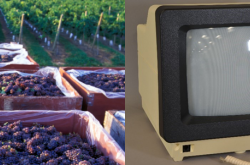The cut nail: A revolutionary technological innovation
We don’t tend to think of nails as revolutionary technological innovations. Most of us don’t likely think of nails at all. And yet, all around us, in all our homes, schools, and offices, hidden under layers of spackle and paint, rest thousands of these ubiquitous metal spikes.
The manufactured cut nail may well be the blandest innovation of the Industrial Revolution, but its invention, combined with cheap and widely available sawn lumber, radically transformed the ability of people to house themselves.
![Examples of manufactured cut nails with their characteristic spike shape A black-and-white image depicts cut nails of different sizes, lying on a flat surface.]](/sites/default/files/styles/inline_image/public/2.png.webp?itok=PMPguO2G)
Nails were an ancient technology, but for millennia homebuilders were faced with a dilemma. Although they were very efficient at binding wood together, nails had to be individually forged by blacksmiths, and buying enough of them to build even a small cottage was beyond the means of most people. Nails were so valuable that when moving, families would often burn their houses down to collect them from the ashes. The other option for homebuilders was the ancient art of joining, the back-breaking work of whittling wooden beams so they slot into each other (like the stereotypical log cabin).
Everything changed with the invention of the nail-cutting machine in the late-eighteenth century. While an artisan blacksmith using traditional methods could make 112 pounds of nails a day, an unskilled labourer operating a machine could produce almost three tons. This revolution brought prices down enough that the average, working-class family could now afford to build homes with sawn lumber and nails.

To produce cut nails, wrought iron bars were heated, then worked into flat sheets by passing them through heavy rollers, making what was called a nail plate. Large manufacturers like Montreal Rolling Mills and Pillow and Hersey & Co. had their own rolling mills, while smaller nail factories purchased their plates.
The nail plate was then inserted into a cutting machine which used a reciprocal motion to shear the iron into a spike shape. In early factories, workers collected the spikes and then hammered on a head by hand. However, by the early nineteenth century, machines were invented which could both cut and then head a nail.


By the late nineteenth century, cut nails began to be replaced by wire nails which were called “pointes de Paris” or “French nails.” These were manufactured by feeding a spool of steel wire through a machine. Although they were not as effective at binding wood, wire nails were significantly cheaper to manufacture; within a few decades they had largely replaced the cut nail in home construction. Nonetheless, the advent of the manufactured cut nail was one of the greatest achievements of the Industrial Revolution, allowing generations of working-class people to house themselves during an incredibly disruptive and tumultuous era.
Enjoying the Ingenium Channel? Help us improve your experience with a short survey!
















